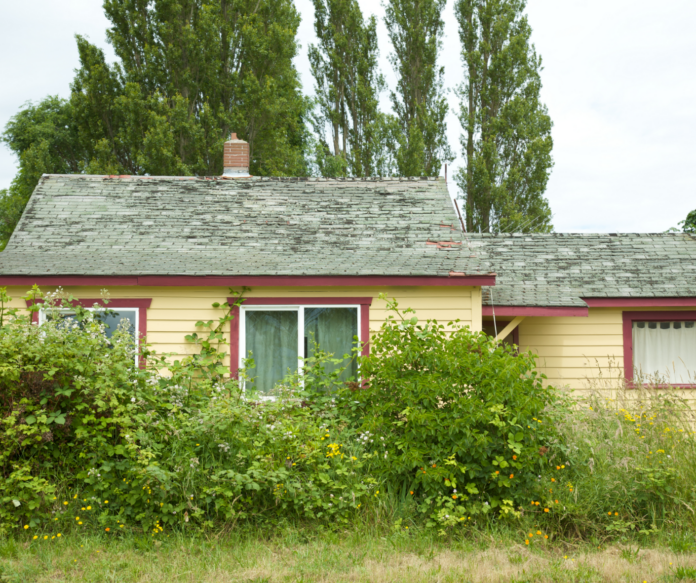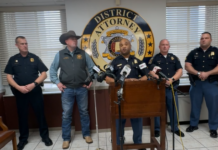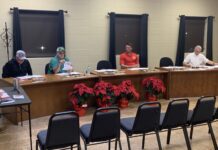CULLMAN, Ala. – The Cullman City Council on Monday night passed a nuisance ordinance “to regulate grass and weed nuisances, abandoned and inoperable vehicles, abandoned/unoccupied dilapidated structures, and other nuisances.” According to City Clerk Wes Moore, the new ordinance will broaden the definition of nuisance to include building materials and other items and will expedite the process for demolishing dilapidated houses.
After an introduction covering applicable sections of the Alabama State Code, the ordinance reads:
WHEREAS, an abundance of abandoned or inoperable vehicles, abandoned overgrown grass and weeds, abandoned and unoccupied dilapidated structures, and other nuisances described herein within the city limits of Cullman, Alabama, could be injurious to the general welfare through being a dangerous public menace and an eyesore, and providing breeding grounds and shelter for rats, mice, snakes, mosquitoes, and other vermin, insects and pests; or attaining heights and dryness that constitute a serious fire threat or hazard; or bearing wingy or downy seeds, when mature that cause the spread of weeds and when breathed, irritation to the throat, lungs, and eyes of the public; or hiding debris such as broken glass or metal that could inflict injury on a person going upon the property, or being unsightly and constituting a usual blight, and;
WHEREAS, it is abundantly clear that municipalities may bring an action to abate a nuisance, and under §6-5-122, “all municipalities in the State of Alabama may commence an action in the name of the city to abate or enjoin any public nuisance injurious to the health, morals, comfort or welfare of the community or any portion thereof.”
WHEREAS, the abatement, enjoinment, demolition, removal and clearance of such abandoned and unoccupied dilapidated structures, abandoned or inoperable vehicles, overgrown grass and weeds, and other nuisances described herein must be accomplished for the overall good and protection of the public as a whole.
WHEREAS, each case of alleged nuisance must be decided upon its own facts on a case-by-case basis.
NOW THEREFORE, BE IT ORDAINED BY THE CITY COUNCIL OF THE CITY OF CULLMAN, AS FOLLOWS:
SECTION I:
- It shall be unlawful for the owner, occupant, or person in charge of a property within the City of Cullman, Alabama, to allow the existence of any abandoned, unoccupied dilapidated structure that is a dangerous public menace that could work hurt, inconvenience, or damage to another, as well as an eyesore.
- It shall be unlawful for the owner, occupant, or person in charge of a property within the City of Cullman, Alabama, whether vacant or not, to use said property for open storage of any inoperable or abandoned motor vehicle, ice box, refrigerator, stove, or other appliance, glass, bottles, tin cans, brush, combustible materials, building materials, building rubbish, and similar items, or to allow the accumulation of weeds, grass, dead trees, brush, trash, garbage, tires, and similar items that create a nuisance and blight on the community, unlawful for an accumulation or storage of debris, refuse, brush, parts of buildings, remains from building demolition, parts of untenantable or uninhabitable structures, used machinery, used tires, used vehicles, parts of vehicles, abandoned vehicles, or any other materials which may provide a breeding place for mosquitoes, harmful insects, rodents and snakes or is so unsightly as to be offensive to the surrounding area is a nuisance in violation of this Ordinance.
- It shall be unlawful to allow garbage to remain exposed in any manner on such person’s premises or on the adjacent street or alley.
- It shall be unlawful for any person to sweep, throw or dispose of trash, waste matter or garbage onto or into property not owned by such person or under such person’s control, except in the landfill as designated by the City in a lawful manner.
- It shall be unlawful for any person to throw or sweep trash, rubbish, garbage, or filth of any kind onto the streets, sidewalks, or public grounds in the City or into waterways, ponds, lakes, or other bodies of water within the City limits of the City of Cullman or direct others to do so.
- It shall be unlawful for any person to permit or maintain the existence of any nuisance on any property under such person’s ownership or control. Property under a person’s ownership and control includes those areas referred to below in “Duties of Owner”. A person with a duty to abate any nuisance is liable for separate and distinct offenses for each day the nuisance is allowed to remain after it has become such person’s duty by notice of the enforcing official to abate it.
- It shall be unlawful and a nuisance, in violation of this Ordinance for the owner of any real property situated within the corporate limits of the City to allow such real property to become overgrown with tall grass or with any weed or plant such as jimson, burdock, ragweed, cocklebur or other weed of like kind or any weed or plant bearing wingy or downy seeds or any weed or plant that is otherwise noxious, dangerous, harmful, or poisonous. Overgrown means a height of 12 inches or more. Excepted from such grass and weed nuisance requirements are:
- Any property which is in its natural condition as defined herein.
- Any property which is located outside any improved subdivision and is located more than 100 feet from any boundary or any lot or parcel of real estate upon which any dwelling is located and more than 100 feet from any commercial enterprise. For good cause the enforcing official may reduce the area subject to this Ordinance to a lesser distance.
- Cultivated row crops and garden plants in their respective growing seasons. But this exception applies only to growing crops and garden plants and shall not be construed to permit any corps or gardens to become overgrown with grass and weeds in violation of the remaining terms of this Ordinance.
SECTION II: For the purpose of this Ordinance, certain terms are defined as follows:
Abandoned Vehicle: A motor vehicle as defined in that has been unclaimed as provided in §32–8–84 for not less than 30 calendar days from the date the notice was sent to the owner and lienholder of record, or if no owner or lienholder of record could be determined, has been unclaimed for not less than 30 calendar days. The term “abandoned motor vehicle” also includes any attached aftermarket equipment installed on the motor vehicle that replaced factory installed equipment. §32-8-84, Code of Alabama 1975 defines an unclaimed motor vehicle as:
- A motor vehicle left unattended on a public road or highway for more than 48 hours.
- A motor vehicle, not left on private property for repairs that has remained on private or other public property for a period of more than 48 hours without the consent of the owner or lessee of the property.
- A motor vehicle, left on private property for repairs, that has not been reclaimed within 48 hours from the latter of either the date the repairs were completed or the agreed upon redemption date.
- Also, any motor vehicle which is in a wrecked, dismantled, partially dismantled, discarded or otherwise inoperable condition, or does not have affixed thereto an unexpired license plate and has been parked, stored or left, whether attended or not, upon any public or private property in the city for a period of time in excess of seven business days.
The term includes any boat, golf-cart, motor bike, or ATV which is in a wrecked, dismantled, partially dismantled, discarded or otherwise inoperable condition. The term does not include any motor vehicle:
- enclosed within a building on private property;
- held in connection with a business enterprise, lawfully licensed by the City on property zoned for junkyard, vehicle repair facility or vehicle storage yard;
- in operable condition specifically adapted or designed for operation on drag strips or raceways;
Building: Any structure or part thereof, not a dwelling as defined in this section.
Dwelling: Any building or structure or part thereof used and occupied for human habitation or intended to be so used, and including any outhouses and appurtenances belonging thereto or usually enjoyed therewith.
Enforcing Official: Any employee designated by the Mayor or the Chief of Police as the person to exercise the authority and perform the duties delegated by this Ordinance to the enforcing official.
Grass or Weed Nuisance: Any abundance of overgrown grass or weeds within the City which is injurious to the general public health, safety and general welfare by providing breeding grounds and shelter for rats, mice, snakes, mosquitoes and other vermin. Insects and pests; or attaining such heights and dryness so as to constitute serious fire threat or hazard; or bearing wingy or downy seeds, when mature, that cause the spread of weeds, and, when breathed, irritation to the throat, lungs, and eyes of the public; or hiding debris, such as broken glass or metal, which could inflict injury on any person going upon the property; or being unsightly; or any growth of grass or weeds, other than ornamental plant growth, which exceeds 12 inches in height.
Improved Subdivision: A division of a tract of land or acreage into tracts or parcels and the improvements thereof by construction of streets, water lines and, where applicable, sewer lines to serve the subdivided property.
Natural Condition: Uncultivated and unseeded land, still in a state of nature. But any growth on land, once it has been cleared or plowed, is not a natural condition, even though it has not been planted or cultivated by anyone.
Nuisance: Defined under §6-5-120 as, “Anything that works hurt, inconvenience or damage to another. The fact that the act done may otherwise be lawful does not keep it from being a nuisance. The inconvenience complained of must not be fanciful or such as would affect only one of a fastidious taste, but it should be such as would affect an ordinary reasonable man.” A nuisance arises from the unreasonable, unwarrantable or unlawful use by a person of such person’s own property, either real or personal, or from such persons own improper, indecent, unsightly or unlawful personal conduct, working an obstruction of or injury to the right of another or of the public, and producing material annoyance, inconvenience, discomfort or hurt to another person or to the general public; anything which is injurious to health, or is indecent or offensive to the senses, or an obstruction to the free use of property, so as to interfere with the comfortable enjoyment of life or property of another.
Owner of Property. Includes legal title holder, or lessee, or occupant of property, or agent of legal title holder or lessee, in charge, possession or control of said property.
SECTION III:
- DUTIES OF OWNER: It shall be the duty of the owner of any real property located within the city to maintain any grass or weeds growing upon said property in such a manner as not to constitute a nuisance. The duties and obligations of the owner extend to and include any real property situated within a dedicated right-of-way or easement burdening the property, except to the extent that it may be impracticable to do so because of public facilities located thereon. Such right-of-way and easements must be maintained by the owner in a manner consistent with the maintenance of the owner’s remaining property and within the requirements in this Ordinance, except to the extent it may be impracticable to do because of public facilities located thereon.
- MAINTENANCE PRACTICES OF CITY: The dedication of and existence of a right-of-way for a public road or of an easement for drainage or for public utilities represents the grant of only a limited interest in property and does not change the actual ownership of the property upon which the right-of-way or easement is located. The public authority maintains rights-of way and easements only to the extent necessary to maintain the public facility and to maintain safety. The owners of the burdened property continues to control the property, except to the extent that such control interferes with the public use. The public authority does not cut grass, weeds, and other growth upon rights-of-way or easements, except to the extent necessary for operations and safety purposes. All other maintenance is the responsibility of the owner of the property upon which the right-of way or easement is located.
SECTION IV:
- Whenever in the opinion of the Enforcing Official, a violation of the Ordinance exists, the Enforcing Official shall order the owner of the property where the nuisance is located to abate the condition. The Enforcing Official shall give the owner written notice either in person or by first class mail requiring the owner to comply with this Ordinance and apprise the owner of the facts of the alleged nuisance and state the date by which the nuisance is to be abated. The notice shall require the owner to complete the abatement of the nuisance within the following period provided that the Enforcing Official shall stipulate additional time but in no case no more than a total of 30 days for any type of nuisance set out in the Ordinance, the Enforcing Official shall give not less than 14 nor more than 30 days for any type of nuisance set out in the Ordinance. Notice shall be sent to that person shown by the records of the county tax collector to have been the last person assessed for payment of ad valorem tax on the property where the nuisance is situated. It shall be the responsibility of that person to promptly advise the Enforcing Official of any change in ownership or interest in the property. It shall be unlawful to knowingly fail to notify the Enforcing Official of any such change of ownership or interest.
- Any employee of the City of Cullman who is designated by the Mayor or Chief of Police as a Code Enforcement Officer is hereby authorized to issue a citation or summons to persons found by him to be in violation of this Ordinance of the City of Cullman.
- The citation or summons shall order the person in violation to appear in Municipal Court at a date and time certain to answer to the charge against him/her. Each citation or summons shall:
- Be in writing and state the facts;
- State the name of the accused;
- State the address of the accused, if known;
- State the offense charged;
- Set forth the date and time the accused is to appear in Municipal Court;
- Set forth the address of the Municipal Court;
- Be signed by the officer issuing or serving the citation or summons; and
- Set forth a warning in bold type that willful failure to appear as directed is a misdemeanor and
that a warrant for failure to appear will be issued.
The complaint may read as follows for any abandoned, unoccupied and dilapidated or untenable structures: “That located on the said described lot is a frame building and this complaint alleges that said building is unoccupied and not tenantable; that said building is in a dilapidated condition, open to the public and to animals; that in its present condition and state of repair it constitutes a fire hazard and a dangerous menace to the CITY OF CULLMAN and is a nuisance under the laws of the State of Alabama, and that the existing conditions, herein described, constitute a flagrant and persistent continuing nuisance in the CITY OF CULLMAN which is dangerous, offensive, unwholesome and injurious to the health, safety and welfare of the CITY OF CULLMAN.”
- A citation or summons delivered to or served upon a person accused of committing a violation or offense in violation of a City Ordinance or Code shall place a duty upon such person to appear in Municipal Court at the time and date indicated thereon and it shall be unlawful for any such person to fail to appear as directed in said citation or summons.
- Failure to appear at the time and date directed shall be prima facie evidence of a willful failure to appear and the Court may cause a warrant to be issued for the accused on a failure to appear charge.
- The provisions of this Ordinance are cumulative with previously granted authority in other ordinances and does not restrict any previously granted authorization to issue citations or summons.
- If the owner or tenant is absent, the enforcing official shall give the owner written notice in person or by first class certified mail with return receipt requested. The notice shall require the owner to comply with this Ordinance and appear before the Court in such manner as set out in Section IV C. The notice shall apprise the owner of the facts of the alleged nuisance and shall name the particular date, time, and place for such hearing. The notice shall be sent to that person shown by the records of the county tax collector to have been the last person assessed for payment of ad valorem tax on the property where the nuisance is situated. It shall be the responsibility of that person to promptly advise the enforcing official of any change in ownership or interest in the property. It shall be unlawful to knowingly fail to notify the enforcing official of any such change of ownership or interest.
SECTION V. Penalties for Violating this Ordinance:
All violation of the provisions of this Ordinance shall be punishable by:
- A fine in the minimum sum of Fifty Dollars ($50.00) up to a maximum of Five Hundred Dollars ($500.00).
- Imprisonment in the municipal jail for a term not to exceed six months.
- Both such fine and imprisonment.
Each offense shall be a specific violation. If the owner fails, neglects or refuses to comply with the notice to abate, enjoin, demolish remove and clear of such abandoned and unoccupied dilapidated structures, building materials, building rubbish, and similar items, abandoned or inoperable vehicles, overgrown grass and weeds, or any act or omission mentioned in §I(B), then the enforcing official shall cause the abatement, enjoinment, demolition, removal and clearance of such abandoned and unoccupied dilapidated structures, abandoned or inoperable vehicles, overgrown grass and weeds by any means permitted by law at the expense of the owner of such property owner. The amount of the cost of abatement of a nuisance by the city, including all court costs, appraisal fees, administrative costs, attorneys’ fees, and all other costs necessarily associated with the abatement action, shall constitute a lien against the real property upon which such costs were incurred. The lien provided for in this section shall be perfected and foreclosed as provided by state law.
SECTION VI. Municipal Court Authority and Summary Abatement:
Any judge of the municipal court of the city shall have the power to order the removal, abatement, demolition, fine or other appropriate judicial remedy of those things which are declared either by this article, state law or federal law to be nuisances, or which are nuisances per se, and from their nature indisputably are so. Summary abatement, without notice to the owner thereof, shall only occur where the nuisance is of imminent and serious danger to the health, safety or general welfare of the citizens of the city and the owner or occupant cannot be notified.
SECTION VII. Severability:
Each and every provision of this Ordinance is hereby declared to be an independent provision and that holding of any provision hereof to be void and invalid for any reason shall not affect any other provision hereof and it is hereby declared that the other provisions of this Ordinance would have been enacted regardless of any provision which might have been held invalid. This Ordinance repeals any prior Ordinance in conflict therewith.
Copyright 2020 Humble Roots, LLC. All Rights Reserved.






























